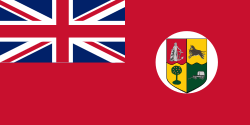 | |
| Use | Civil ensign [note 1] |
|---|---|
| Proportion | 1:2 |
| Adopted | 1910 |
| Relinquished | 1951 |
| Design | A Red Ensign with the coat of arms of South Africa on a white disc |
The South African Red Ensign was the civil ensign of Union of South Africa from 1910 to 1951. From 1910 to 1928, the flag was also viewed as the unofficial flag of South Africa. The design of the flag was a red ensign defaced with the coat of arms of South Africa on a white disc.
History


When the Union of South Africa was created in 1910, the only flag that had official status within it was the Union Jack as part of the British Empire. A new coat of arms was created in September of that year, with Admiralty warrants being issued in December authorising usage of the arms on a red ensign. [1] Though they were intended for maritime usage, the South Africa Red Ensign was used on the land as a de facto national flag similar with other colonies and dominions within the British Empire. In 1912, a royal warrant was issued amending the South Africa Red Ensign so that the arms were on a white disc to bring it into line with a rule in the Admiralty Flag Book requiring the arms to be on a white disc if any part of them were the same colour as the field of the ensign. [2] [1] In 1915, Louis Botha raised the South Africa Red Ensign over Windhoek after the British Empire's conquest of German South-West Africa as part of the South-West Africa campaign. [2]
Replacement as an unofficial national flag

Despite the South Africa Red Ensign being the de facto flag, it was not popular with either British or Afrikaner communities. [2] Afrikaners, because it contained the Union Jack, and British settlers, because it was not the Union Jack alone. [3]
In 1925, following the 1924 general election in which J. B. M. Hertzog was elected as the first National Party Prime Minister of South Africa, a bill was introduced to the Parliament of South Africa by D. F. Malan for a new flag of South Africa which Malan had hoped for, a "clean flag" without the Union Jack. [4] [5] Discussions to change the flag resulted in three years of volatile negotiations as Afrikaner descendants of Boers who fought in the Boer War found the Union Jack in the flag unacceptable, while British settlers felt that the Afrikaner voting majority was attempting to remove British imperial symbols, and Natal Province threatened to secede if the Union Jack was removed. [4] A compromise was reached after three years whereby the new flag would feature the Union Jack in a reduced position and not as an ensign. The Union Nationality and Flags Act 1928 also provided that the new flag of the Union of South Africa and the Union Jack would be flown together as joint official flags of South Africa. [6] [7]
The South Africa Red Ensign ceased being used as the unofficial national flag but was retained in maritime usage as the merchant ensign until 1951. [8]
Notes
- ^ The South African Red Ensign was also viewed as an unofficial flag of South Africa from 1910 to 1928. However, the ensign was never formally adopted as a national flag.
References
- ^ a b Brownell, Frederick Gordon (May 2011). "Flagging the 'new' South Africa, 1910-2010". Historia. 56 (1): 42–62.
- ^ a b c Burgers, A.P. (2008). The South African flag book: the history of South African flags from Dias to Mandela. Protea Book House. pp. 152–153. ISBN 978-1-86919-112-2.
- ^ Murphy, Allison (1989). The South African family encyclopaedia. Struik Publishers. p. 124. ISBN 978-0-86977-887-6.
- ^ a b "South Africa (1928-1994)". Crwflags.com. Retrieved 2016-09-02.
- ^ Boddy, Alistair. "Daniel Francois Malan - A Biography of DF Malan". Africanhistory.com. Retrieved 2016-09-08.
- ^ "1927. Union Nationality & Flag Act". The O'Malley Archives. Retrieved 2016-09-02.
- ^ Fallan, Kjetil (2016). Designing Worlds: National Design Histories in an Age of Globalization. Berghahn Books. p. 65. ISBN 978-1-78533-155-8.
- ^ Merchant Shipping Act 1951 (South Africa); South Africa Government Gazette No 6085 dated 25 July 1958.